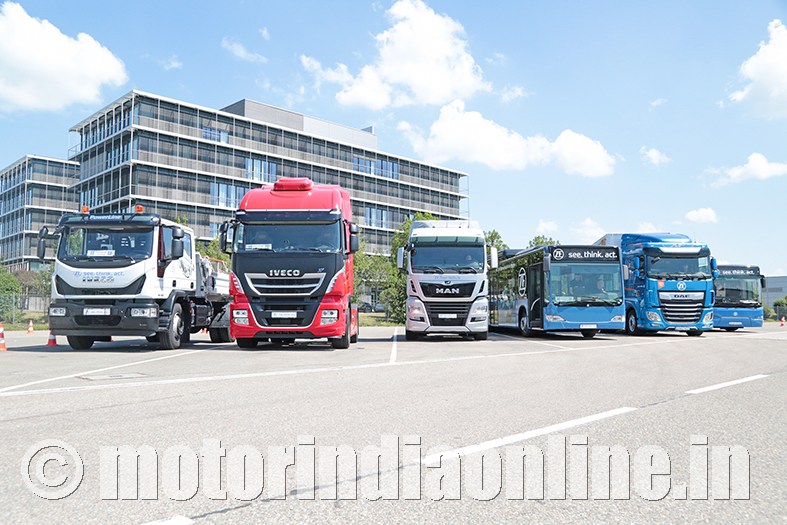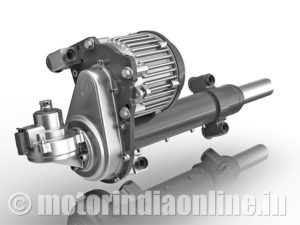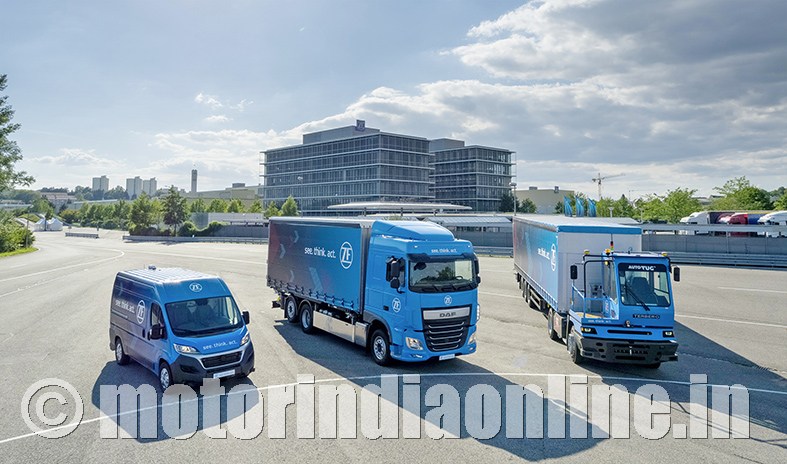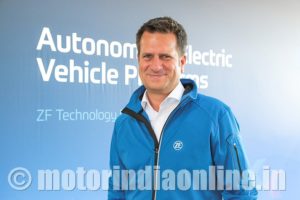ZF, a global leader in driveline and chassis technology and active & passive safety, gave a glimpse into the future with an exhaustive display of a range of next-generation mobility solutions at its 2018 Technology Day held at the company headquarters in Friedrichshafen, Germany. MOTORINDIA was part of an Indian media delegation that was invited to attend the event and get a first-hand experience of how the German expert is driving future mobility with a number of technologies and solutions pertaining to the key aspects of vehicle performance, fuel efficiency and safety and also emerging megatrends such as connectivity, hybridization, electrification and automatization.
In this report, we take a look at some of the many impressive technologies showcased and demonstrated by ZF at its Technology Day.
New electric central drives
ZF has complemented its portfolio of electrification solutions for commercial vehicles with two new electric central drives – CeTrax lite and CeTrax mid. Both are all-electric plug and drive solutions designed for use in delivery vans, light commercial vehicles up to 7.5 tons (CeTrax lite) as well as medium-duty commercial vehicles up to 19 tons (CeTrax mid). With these two solutions, the company aims to serve further market segments in the future and support the industry on its way to local zero-emission driving.
With CeTrax lite and CeTrax mid, ZF is expanding its electric drive portfolio for commercial vehicles in vehicle categories of up to 19 tons gross vehicle weight. What makes CeTrax lite and CeTrax mid unique is the electric central drive’s integrated design, in which the electric motor, power electronics and transmission form a compact unit with a shared housing. This means that the power electronics do not need to be wired separately with the electric motor, as this connection already exists within the unit. Thanks to their compact design, both central drives can be installed flexibly in existing vehicle platforms, eliminating the need for major changes to chassis or axles by vehicle manufacturers.
Along with its proven AVE 130 electric portal axle and the new CeTrax electric central drive for city buses, ZF now becomes a one-stop shop for all components required for city bus applications.
ReAX EPS
Another interesting unveiling at the Technology Day was ZF’s ReAX EPS, the world’s first prototype of a fully-electric steering system for commercial vehicles that eliminates the need for hydraulics and associated peripheral components. Its powerful electric motor offers complete servo power of up to 70 Nm. Additionally, ZF’s Electrically Powered Steering (EPS) system is designed to support steer-by-wire applications in the future. Fully-electric steering is an important enabler for advanced driver assistance systems (ADAS) and automated drive functions that can help to improve safety as well as relieving drivers and improving logistics workflow. Moreover, the ZF ReAX EPS offers increased efficiency with reduced packaging space and weight, compared to traditional hydraulic steering systems.
“With the ReAX EPS, we are presenting a prototype for a commercial vehicle steering system that can simplify and accelerate the advance of electrification, including 48V on-board vehicle power supply systems and steer-by-wire options, and do so with the high efficiency and reliability,” said Mitja Schulz, Head of CV Steering Systems, ZF.
Smart Logistics
With two innovative solutions, ZF showed how ‘Smart Logistics’ solutions could transform depots and forwarding companies at sea and airports and other specified areas. In future, the vehicles could autonomously manoeuvre swap bodies or trailers to their respective destinations. This is based on the company’s key principle “see. think. act”. Building on this, ZF develops means for the logistics sector to increase efficiency, speed and environmental friendliness whilst reducing accidents and avoiding damage. Last but not least, driverless vehicles with the ability to manoeuvre help counter the ever-growing shortage of skilled workers in the logistics industry.
With the ZF Innovation Truck and the Terminal Yard Tractor, ZF offers future-oriented solutions to the central challenges faced by forwarding companies: “Autonomous vehicles that, thanks to our technologies, can see, think and act are turning the idea of consistent smart logistics into reality, at depots and other specified areas,” stated Fredrik Staedtler, Head of ZF’s Commercial Vehicle Technology Division. “These vehicles can prevent manoeuvring damage and downtimes, which gives logistics companies a competitive advantage. The functions presented in our current innovation vehicles are therefore applications that are in high demand and pay off quickly.”
Whilst ZF proAI is the Innovation Truck’s brain, other ZF technologies enable it to act: among others, the active electrohydraulic ReAX commercial vehicle steering system and the TraXon Hybrid automatic transmission system. The latter is characterized by a modular integrated electric motor that allows locally emission-free driving. A cost-effective, camera-based and laser-supported sensor setup, completed with a GPS system, gives the ZF Innovation Truck its orientation and vision.
In addition to the Innovation Truck and the Terminal Yard Tractor, ZF also demonstrated how its Innovation Van could be a game-changer in applications such as courier & parcel delivery. There was another innovative machine that moved around at the display area without any human intervention – the ZF Innovation Forklift, an Industry 4.0 solution, that can perform material handling operations autonomously in what the company calls a ‘Model Factory’.
“We want to be a system solution provider for customers”
– Mr. Wilhelm Rehm, Member of the Board of Management, ZF
We spoke to Mr. Wilhelm Rehm, Member of the Board of Management, responsible for Corporate Materials Management, Commercial Vehicle Technology and Industrial Technology at ZF Friedrichshafen AG, who tells us about ZF’s growth plans for the Asia Pacific region, exports out of India and ‘system provider’ approach.
Excerpts:
What are ZF’s next steps for the Indian market?
The major step in front of the Indian market now is the move to Euro-VI (BS-VI) from 2020. With this change, the market needs higher efficiency on the driveline which we hope will drive the move from manual transmission to automated transmissions. This will be the next step together with the Euro-VI legislation and ZF is gearing up for the same. We have to be ready for the Euro-VI development and are looking to expand our plant in Pune and also make best use of the Software Engineering Centre we opened in Hyderabad last year. We will be a partner for the OEMs not just for transmissions but also for steering systems, braking systems and other solutions.
Given the volume growth of the Asia Pacific region, how important is this market for ZF at present?
We divide Asia Pacific into China, India and the rest of Asia. We have a major project to grow in China and India and are trying to build up the resources in the region for the region. In China, we have built an Engineering Centre in Shanghai, and have another one at Nanjing through TRW. Given the importance of the truck market in China we have formed a JV with Foton and are building up a plant in the country. Through this JV, we can deliver products to Foton and also to third-party customers which will bring us closer to the Chinese OEMs.
In India, we have a fully-owned facility and plan to further expand the same. We are looking to localize our Automated Manual Transmission (AMTs) and also bring in the hybrid solution, though it will take time. We have seen a fuel efficiency improvement of four per cent with one of our European customers with the Traxon AMT transmission. This is possible only with a collaboration between the engine and the transmission which we are doing through our ‘CV Motion Control’ approach. Through such an approach we are willing to provide a full solution – transmission with related components, software adaptation, control units, etc. – for our OEM customers; this is our direction – to be a system provider for our customers.
ZF’s exports out of India have grown significantly in recent times. What are your plans on this front?
Around three years back at the Hanover Fair, the Indian Prime Minister gave a speech about ‘Make-in-India’. This gave us the direction to set a target of Euro 100 million worth exports out of India which we have successfully achieved. We have now doubled our target to Euro 200 million. Our aim is to have a secured supply chain to all our plants out of India. We have a purchasing hub with teams at Hyderabad, Pune and Coimbatore which are directly connected to our European team. India is a very important sourcing market for ZF and we deliver a number of parts from India to the US and also to Germany and other parts of Europe.
“We see a readiness in the customer base in the Indian market for ZF products based on TCO”
– Mr. Fredrik Staedtler, Head of Division, Commercial Vehicle Technology, ZF
Mr. Fredrik Staedtler, Head of Division, Commercial Vehicle Technology, ZF Friedrichshafen AG, is excited about the forward-looking developments that have taken place in the Indian market over the last couple of years. He talks to us about the prospects of ZF’s new technologies in India, its localization drive, TCO-driven approach and more.
Excerpts:
How do you see the acceptance of your new technologies such as the CeTrax, EPS for heavy trucks and TraXon hybrid in emerging markets like India?
The beauty of commercial vehicles is that there are so many different aspects, segments and use cases. Every one of these use cases has a specific requirement that can satisfy either a light commercial electrification, a delivery van application, a bus or coach application or even for long-haul. We see in principal all of these technologies apply for all markets. We understand that some markets have central drive-oriented solutions and not so many axle-driven solutions. ZF is willing to offer all technologies because we fundamentally believe it will take quite a long time until one single solution will prevail. There are benefits to each of them but at the end of the day it very much depends on what each market requires and what the OEMs want to drive in their new vehicle concepts or existing chassis. We have developed a wide array of products to satisfy different kinds of applications.
We understand that ZF is planning to localize more products in the Indian market. Could you tell us more on this?
We are very excited about the development of the Indian market and the changes that have happened over the last 12 to 24 months. We really see a big opportunity for a stronger TCO-driven decision-making process which would provide a lot of opportunities for ZF technologies. Our products are not known to be the cheapest solution but from a TCO perspective we can provide very good use cases.
The demand for our transmissions from the Indian market has increased tremendously in volumes and with it comes the necessity and opportunity for us localize more. We currently supply 6- and 9-speed transmissions in the Indian truck market and will step up our localization drive. We also plan to localize some of our chassis components like shock absorbers; on the whole, various products on both chassis and drivetrain sides will be localized.
What are the factors driving your localization plan? Do you see the Indian market focusing more on TCO as against the initial product acquisition cost?
For sure; we will increase our footprint, build upon our existing presence and localize more components and technologies because we see a readiness in the customer base for ZF products based on TCO in the Indian market. For us, it’s only about the TCO; the fact that a vehicle can be on the road longer without too much of stoppage or waiting time gives an opportunity to the logistics firms and fleets to consolidate and increase their professionalism, while it also gives relief to the drivers and reduces maintenance cost and time. For the vehicle to have higher uptime, the components have to perform better and support the system – this is a big growth driver for us.
In addition, India is peeking into the future of electrification, automatization and connectivity and we believe these trends are coming quite quickly; if all three come together, it’s almost like a revolution in the market. ZF wants to be ready and is ready and I think we have a good opportunity based on the fact that we have a wide range portfolio, continuously developing our well-known technologies based on offering the lowest TCO, improving fuel efficiency and enhancing safety.
What is your approach towards introducing futuristic technologies for the Indian bus market?
On the bus side, it’s always a joint effort from ZF, the OEMs as well as the transport authorities and fleet operators who run the buses. We have always engaged in direct discussions with the fleets because they are not only interested in buying the vehicle or the component but also want to ensure it is serviced in the right way. In their feedback, our customers have reaffirmed that ZF is able to look into existing technologies, future technologies and a mix of both that are being deployed in Indian cities and is also able to service these technologies well. This is one big advantage that ZF has and as a result, our customers feel they can have both conventional drivetrains as well as electrified drivetrains since we can offer and service them both.
We see a big push on AMT in the coming years and also a big push on AT technology continuously, not only in buses but also in trucks which is why when we expand our footprint in India we will also need to increase our service and aftermarket support across the country.




